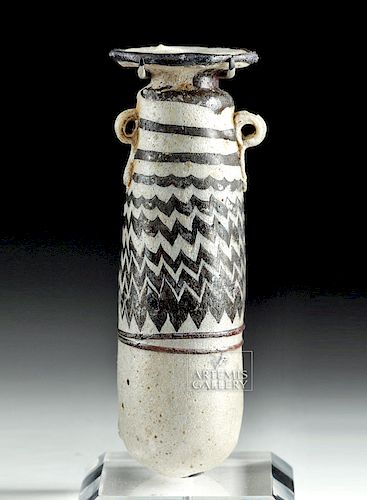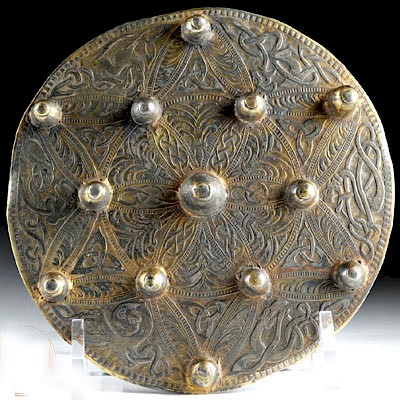Gorgeous Greek Glass Core-Form Alabastron
Lot 12
About Seller
Artemis Fine Arts
686 S Taylor Ave, Ste 106
Louisville, CO 80027
United States
Selling antiquities, ancient and ethnographic art online since 1993, Artemis Gallery specializes in Classical Antiquities (Egyptian, Greek, Roman, Near Eastern), Asian, Pre-Columbian, African / Tribal / Oceanographic art. Our extensive inventory includes pottery, stone, metal, wood, glass and textil...Read more
Estimate:
$6,000 - $9,000
Absentee vs Live bid
Two ways to bid:
- Leave a max absentee bid and the platform will bid on your behalf up to your maximum bid during the live auction.
- Bid live during the auction and your bids will be submitted real-time to the auctioneer.
Bid Increments
| Price | Bid Increment |
|---|---|
| $0 | $25 |
| $300 | $50 |
| $1,000 | $100 |
| $2,000 | $250 |
| $5,000 | $500 |
| $10,000 | $1,000 |
| $20,000 | $2,500 |
| $50,000 | $5,000 |
| $100,000 | $10,000 |
| $200,000 | $20,000 |
About Auction
By Artemis Fine Arts
Jul 19, 2018
Set Reminder
2018-07-19 10:00:00
2018-07-19 10:00:00
America/New_York
Bidsquare
Bidsquare : Fine Antiquities/Ethnographic Art
https://www.bidsquare.com/auctions/artemis-gallery/fine-antiquities-ethnographic-art-3329
Featuring classical antiquities, ancient and ethnographic art from cultures encompassing the globe, plus fine art. Artemis Fine Arts info@artemisgallery.com
Featuring classical antiquities, ancient and ethnographic art from cultures encompassing the globe, plus fine art. Artemis Fine Arts info@artemisgallery.com
- Lot Description
Ancient Greece, Classical period, ca. late 6th to early 5th century BCE. A stunning opaque glass alabastron with a simple presentation and fabulous coloration. The elegant and gently-tapering body has a rounded base, smooth walls, a pair of petite suspension loops, a narrow neck, and a dark-ringed discoid neck. Gorgeous tooled translucent purple zigzag-trail patterns coil around the body with an applied rigaree trail beneath. Age and environmental conditions have altered the amethyst hue into a dark espresso color on one half. Faint areas of rainbow-hued iridescence radiate across the creamy-white composition, making it an exquisite example replete with impeccable form, beautiful coloration, and sophisticated technique. Custom lucite display stand included. Size: 1" W x 3.75" H (2.5 cm x 9.5 cm); 4.3" H (10.9 cm) on included custom stand.
The alabastron is a long-bodied vessel with a rounded bottom, a cylindrical neck, and a flat disk for a mouth. Though usually without handles, some alabastra have eyes or lugs, like this example. According to the Beazley Archive of the University of Oxford, the alabastron shape's history extends back to Corinth, but was only preserved in Athenian pottery examples back to the mid-sixth century BCE. Alabastra were created in many materials, including alabaster, and the Greek term for this stone - alabastron (most likely of Egyptian origin) - was the source of inspiration for the name of this shaped vessel. Many examples were finished with a white ground, as if to imitate this stone. We know from vase painting imagery of women using alabastra following a bath, that these vessels most likely held perfumed oils.
According to the Corning Museum of Glass, core forming is "the technique of forming a vessel by winding or gathering molten glass around a core supported by a rod. After forming, the object is removed from the rod and annealed. After annealing, the core is removed by scraping." (https://www.cmog.org/glass-dictionary/core-forming). This process of glass making was begun in the late 16th century BCE by glassmakers of Mesopotamia, and then adopted by Egyptian glassmakers in the 15th century BCE. The technique almost came to an end in the so-called Dark Ages of Mediterranean civilization (1200 to 900 BCE); however, by the 9th century BCE a new generation of glassmakers took up the technique once again, and between the 6th and 4th century BCE core-forming spread throughout the Mediterranean.
For a similar example, please see The Metropolitan Museum of Art, accession number 81.10.313: https://www.metmuseum.org/art/collection/search/245463
Provenance: private East Coast, USA collection
All items legal to buy/sell under U.S. Statute covering cultural patrimony Code 2600, CHAPTER 14, and are guaranteed to be as described or your money back.
A Certificate of Authenticity will accompany all winning bids.
We ship worldwide and handle all shipping in-house for your convenience.
#133238Surface wear and abrasions commensurate with age as expected, slight fading to coloration, minor pitting, and some surface roughness, otherwise intact and excellent. Light earthen deposits within recessed areas, and nice rainbow iridescence throughout. Some purple areas now exhibit a dark-brown color due to age and the environmental exposure.Condition
- Shipping Info
-
All shipping is handled in-house for your convenience. Your invoice from Artemis Gallery will include shipping calculation instructions. If in doubt, please inquire BEFORE bidding for estimated shipping costs for individual items.
-
- Buyer's Premium



 EUR
EUR CAD
CAD AUD
AUD GBP
GBP MXN
MXN HKD
HKD CNY
CNY MYR
MYR SEK
SEK SGD
SGD CHF
CHF THB
THB














